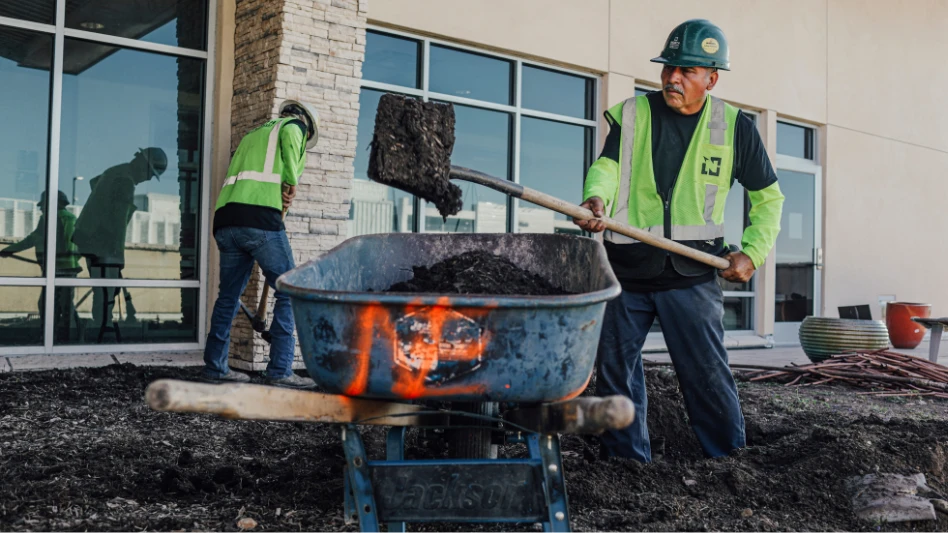Architects, clients and contractors have a wide variety of materials to choose from when constructing hardscape projects. With materials ranging from granite and marble to clay and concrete, it’s important to the success of the project that you choose carefully.
First, determine the size and scope of the project. This enables you to get prices and allows the hardscape contractor to provide suggestions and develop an informed bid. If the subcontractor knows what they are doing, they will know that each material has advantages and disadvantages. These are reflected in the cost of the labor. You must realize that some natural stone products might cost between two and four times more to install than dimensional manufactured concrete or clay. Even so-called dimensional natural stone, like some granite pavers, requires substantially more skill and time to install.
Second, establish the suitability of the material for the application and climate. I’ve seen too many lannon stone (limestone) walls on streets that are salted during the winter, causing the stone to disintegrate within a few years.
Remember, hardscaping is the use of hard, long lasting materials in a landscape. Hardscapes should be designed to provide long lasting value and minimal maintenance. Designers incorporating wood or any other limited life material into their hardscape design should reconsider their choice, especially if it is a structural part of the design.
Third, make sure any subcontractor has substantial experience with the chosen material and type of installation. Check references.
WALLS AND MALLS. The two main types of hardscaping projects are paving and retaining walls. Paving can be divided into two categories: flexible and rigid. Flexible paving usually consists of a compacted granular base (road base) and a setting bed of coarse sand for dimensional materials like concrete or clay pavers. Stone dust may be used for nondimen-sional material like granite cobbles, slabs or limestone.
This type of installation requires an extensive knowledge of compaction and local base material. Flexible paving also requires a separate edge restraint, such as a concrete curb or a plastic restraint (not lawn edging) designed specifically for the horizontal loads of the pavement.
Rigid paving is where the base is poured concrete or asphalt. A number of different methods for applying the materials exists. First, high strength mortars are available today that do a reasonable job for setting stone or pavers. The biggest problem is longevity in northern climates where problems can occur. There is also the problem of any cracking in the slab below, causing surface distress. It is also quite expensive.
New adhesives are available that do a better job than mortars but are limited to the more dimensional materials because adhesives do not fill large gaps well. Another method is to apply your material over asphalt. This would be a semi-rigid pavement (asphalt is considered a flexible pavement). This will work if you use a filter cloth on top of the asphalt before you spread a setting bed. You must either use a concrete curb or plastic paver edging to restrain the edges. Bituminous setting beds have been used for many years but are difficult to successfully install. There are no real benefits to a bituminous setting bed that justify its difficulty and cost.
Also deserving mention is step construction. This is almost always an overlay on concrete. Natural stone is usually best suited to high strength latex mortars, while dimensional products like concrete pavers and brick are best suited to adhesive.
Retaining walls can be divided into two categories: structural and decorative. Structural retaining walls have two basic types: dry stack interlocking concrete and poured reinforced concrete. Most other types are for highway construction.
You can incorporate natural stone in structural retaining walls by using the natural stone for the cap or coping. This adds a nice accent. Adding natural stone within 3 feet of the top of the wall using adhesive for the interlock is also a nice touch. These are inexpensive ways to enhance a structural concrete retaining wall. Do not forget that most concrete retaining walls are available in various colors and textures. Try mixing them up.
A poured concrete wall allows you to face the wall with materials such as clay brick, natural stone, stucco or a painted mural. Decorative retaining walls are typically less than 4 feet high. If properly designed with drainage, set back and built on a solid compacted granular base or a poured concrete footer, you can use just about any material to build the wall. Remember, the more money and effort put into the base, the better the wall.
Quarried natural stone is suitable for decorative retaining walls, though it takes a real craftsman to make it look good. Boulder walls are also a nice option, but an experienced contractor is a must for one of any height. And always remember to bury at least 2 inches of the wall for each 12 inches of exposed wall height.
When hardscaping near a building, take care determining water runoff and surface elevations. Remember to keep each hardscape project in scale with the entire project. It should enhance the overall setting, not dominate it. Colors can affect the impact of your hardscape project so strive for contrasts rather than close matches.
A successful hardscape installation combines the customer’s desires, the architect’s comprehension and feeling for the site and materials, and the contractor’s craftsmanship and interpretation of the project.
The author is president of Pave Tech Inc., Bloomington, Minn.
Get curated news on YOUR industry.
Enter your email to receive our newsletters.
Explore the February 1997 Issue
Check out more from this issue and find your next story to read.
Latest from Lawn & Landscape
- Ever-changing landscape of SEO
- Fleetio acquires Auto Integrate, raises $450M in Series D funding
- Davey Tree expands in St. Paul, promotes Ostlie to district manager
- Schill Grounds Management taps 3 for senior leadership roles
- HD Hyundai Construction Equipment North America adds to wheeled excavator lineup
- High maintenance
- From Design to Proposal: Estimating and Rendering Support Services
- PERC adds Joel Stutheit as senior manager of business development





